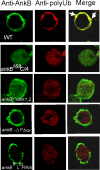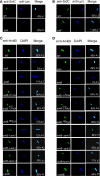Molecular Characterization of Exploitation of the Polyubiquitination and Farnesylation Machineries of Dictyostelium Discoideum by the AnkB F-Box Effector of Legionella Pneumophila
- PMID: 21687415
- PMCID: PMC3109286
- DOI: 10.3389/fmicb.2011.00023
Molecular Characterization of Exploitation of the Polyubiquitination and Farnesylation Machineries of Dictyostelium Discoideum by the AnkB F-Box Effector of Legionella Pneumophila
Abstract
The Dot/Icm-translocated Ankyrin B (AnkB) F-box effector of Legionella pneumophila is essential for intra-vacuolar proliferation and functions as a platform for the docking of polyubiquitinated proteins to the Legionella-containing vacuole (LCV) within macrophages and ameba. Here we show that ectopically expressed AnkB in Dictyostelium discoideum is targeted to the plasma membrane where it recruits polyubiquitinated proteins and it trans-rescues the intracellular growth defect of the ankB null mutant, which has never been demonstrated for any effector in ameba. Using co-immunoprecipitation and bimolecular fluorescence complementation we show specific interaction of Skp1 of D. discoideum with the F-box domain of AnkB, which has never been demonstrated in ameba. We show that anchoring of AnkB to the cytosolic face of the LCV membrane in D. discoideum is mediated by the host farnesylation of the C-terminal eukaryotic CaaX motif of AnkB and is independent of the F-box and the two ANK domains, which has never been demonstrated in ameba. Importantly, the three host farnesylation enzymes farnesyl transferase, RCE-1, and isoprenyl cysteine carboxyl methyl transferase of D. discoideum are recruited to the LCV in a Dot/Icm-dependent manner, which has never been demonstrated in ameba. We conclude that the polyubiquitination and farnesylation enzymatic machineries of D. discoideum are recruited to the LCV in a Dot/Icm-dependent manner and the AnkB effector exploits the two evolutionarily conserved eukaryotic machineries to proliferate within ameba, similar to mammalian cells. We propose that L. pneumophila has acquired ankB through inter-kingdom horizontal gene transfer from primitive eukaryotes, which facilitated proliferation of L. pneumophila within human cells and the emergence of Legionnaires' disease.
Keywords: SCF1; Skp1; dot/Icm; farnesyl; prenylation.
Figures








Similar articles
-
Cellular microbiology and molecular ecology of Legionella-amoeba interaction.Virulence. 2013 May 15;4(4):307-14. doi: 10.4161/viru.24290. Epub 2013 Mar 27. Virulence. 2013. PMID: 23535283 Free PMC article. Review.
-
Exploitation of evolutionarily conserved amoeba and mammalian processes by Legionella.Trends Microbiol. 2012 Jun;20(6):299-306. doi: 10.1016/j.tim.2012.03.005. Epub 2012 Apr 9. Trends Microbiol. 2012. PMID: 22494803 Free PMC article. Review.
-
Molecular mimicry by an F-box effector of Legionella pneumophila hijacks a conserved polyubiquitination machinery within macrophages and protozoa.PLoS Pathog. 2009 Dec;5(12):e1000704. doi: 10.1371/journal.ppat.1000704. Epub 2009 Dec 24. PLoS Pathog. 2009. PMID: 20041211 Free PMC article.
-
Exploitation of conserved eukaryotic host cell farnesylation machinery by an F-box effector of Legionella pneumophila.J Exp Med. 2010 Aug 2;207(8):1713-26. doi: 10.1084/jem.20100771. Epub 2010 Jul 26. J Exp Med. 2010. PMID: 20660614 Free PMC article.
-
Indispensable role for the eukaryotic-like ankyrin domains of the ankyrin B effector of Legionella pneumophila within macrophages and amoebae.Infect Immun. 2010 May;78(5):2079-88. doi: 10.1128/IAI.01450-09. Epub 2010 Mar 1. Infect Immun. 2010. PMID: 20194593 Free PMC article.
Cited by
-
Cellular microbiology and molecular ecology of Legionella-amoeba interaction.Virulence. 2013 May 15;4(4):307-14. doi: 10.4161/viru.24290. Epub 2013 Mar 27. Virulence. 2013. PMID: 23535283 Free PMC article. Review.
-
Effect of Bacterial Infection on the Edibility of Aquatic Products: The Case of Crayfish (Procambarus clarkii) Infected With Citrobacter freundii.Front Microbiol. 2021 Sep 29;12:722037. doi: 10.3389/fmicb.2021.722037. eCollection 2021. Front Microbiol. 2021. PMID: 34659149 Free PMC article.
-
Bacterial toxin effector-membrane targeting: outside in, then back again.Front Cell Infect Microbiol. 2012 May 31;2:75. doi: 10.3389/fcimb.2012.00075. eCollection 2012. Front Cell Infect Microbiol. 2012. PMID: 22919666 Free PMC article. Review.
-
Rapid nutritional remodeling of the host cell upon attachment of Legionella pneumophila.Infect Immun. 2014 Jan;82(1):72-82. doi: 10.1128/IAI.01079-13. Epub 2013 Oct 14. Infect Immun. 2014. PMID: 24126522 Free PMC article.
-
Exploitation of evolutionarily conserved amoeba and mammalian processes by Legionella.Trends Microbiol. 2012 Jun;20(6):299-306. doi: 10.1016/j.tim.2012.03.005. Epub 2012 Apr 9. Trends Microbiol. 2012. PMID: 22494803 Free PMC article. Review.
References
-
- Amer A. O. (2010). Modulation of caspases and their non-apoptotic functions by Legionella pneumophila. Cell. Microbiol. 12, 140–147 - PubMed
-
- Berger K. H., Isberg R. R. (1993). Two distinct defects in intracellular growth complemented by a single genetic locus in Legionella pneumophila. Mol. Microbiol. 7, 7–19 - PubMed
-
- Bergo M. O., Leung G. K., Ambroziak P., Otto J. C., Casey P. J., Young S. G. (2000). Targeted inactivation of the isoprenylcysteine carboxyl methyltransferase gene causes mislocalization of K-Ras in mammalian cells. J. Biol. Chem. 275, 17605–17610 - PubMed
Grants and funding
LinkOut - more resources
Full Text Sources

